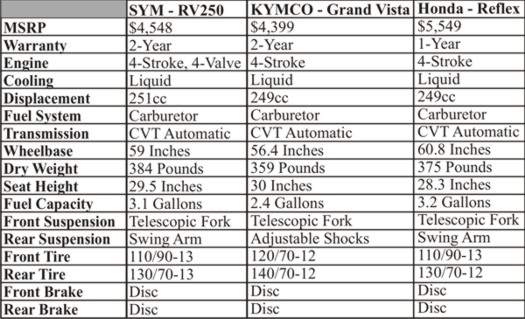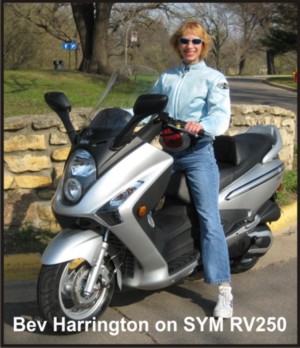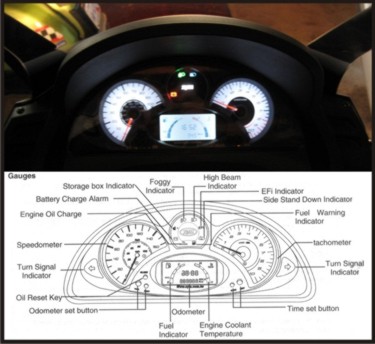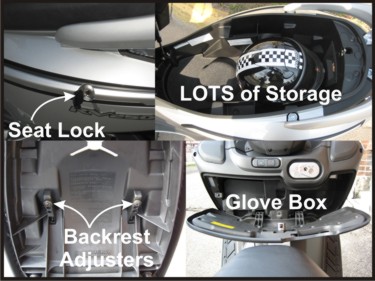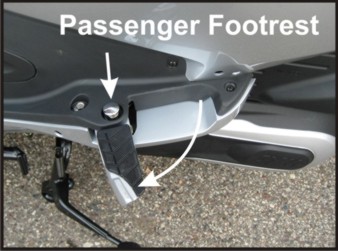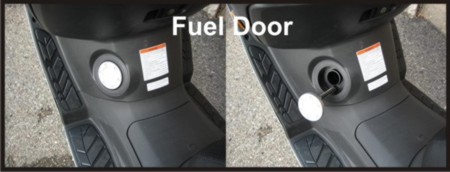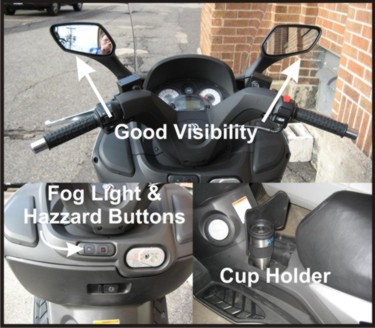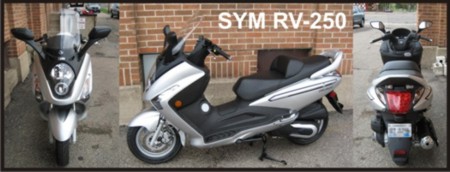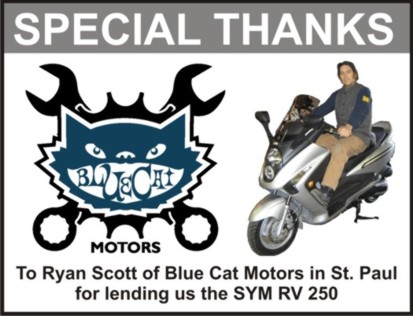May 2010 – SYM has lowered the MSRP on the RV250 from $4,988 to $4,4969
May, 2008 – Ever since I reviewed the SYM HD-200 (August of 2007) I have been chomping at the bit to get more SYM scooters to review. Ryan Scott at Blue Cat Motors, here in St. Paul Minnesota, was kind enough to let me have a new RV250 for several days.
SYM (San Yang Motors) is based in Taiwan and has been around since 1961. As those of you who have read some of my other reviews will know, Taiwanese scooters are among the best in world, and SYM only adds to that reputation for quality. The four-stroke engines from SYM have some outstanding features including ceramic coating of the cylinder which means no carbon deposits and a longer life for the motor. The cylinder heads are a one-piece design (as opposed to the more conventional two-piece) which is stronger and makes for better dissipation of heat. SYM uses a four-valve design for enhanced performance.
I rode the SYM RV250 solo and with my wife, Beverly. She also rode the RV250 solo. I had a number of people try out the scooter for fit and came across a couple of potential issues for some buyers. Overall, Bev and I were both impressed with the RV250.
 Speedometer Reading/Speed/Fuel Economy
Speedometer Reading/Speed/Fuel Economy
The most common questions people ask me when I’m on a scooter are along the lines of “How much does it cost, how fast will it go, and what kind of fuel economy do you get?” The first one is easy; the RV250 has a base price of $4,548.00. How fast will it go? I did test both speedometer accuracy and top end with a GPS unit. No surprise here – like most scooters the RV250 speedometer was optimistic, very nearly 10% optimistic. When the speedometer indicated 40 MPH, the actual speed was 36 MPH. As I mentioned earlier, this was a new scooter from Blue Cat and I’m not one to thrash the living daylights out of what will be someone else’s scooter. I did run the RV250 up to an indicated 80 MPH, an actual speed of 72 MPH. I expect that after the scooter is broken in, it will do somewhat better than that for the top end. In mixed riding (city, highway, solo, 2-up) I got 57 Miles per gallon which I consider a perfectly respectable number.
Features
The SYM RV250 falls squarely into the maxi-scooter class. This machine was meant to see highway use and it gobbles up the miles quite well. For comparison, I selected the Kymco Grand Vista (Grand Dink in other countries) and the Honda Reflex. All three are maxi-scooters with a relatively low seat height and weight. I have ridden both the Kymco and the Honda, and all three are comparable in performance. All three are also good choices for those of us with shorter legs.
This brings me to the first potential “issue” with the SYM RV250 – if you have long legs, this scooter is probably not going to be a good fit for you. I’m just under 5’ 9” (or a towering 5’ 8”, depending on your perspective) and the RV250 fits me just fine. My wife is 5’ 6” and it fits her very well. Of course this same concern would also apply to the Kymco Grand Vista and the Honda Reflex.
The SYM RV250 has great lighting. SYM uses the Phillips HID headlight and LED taillights. The RV250 also has fog lights and emergency flashers which are activated by buttons just to the left of the ignition switch. The gauges on the dash are clear and easy to read.
Storage includes a glove box (with a power socket) and MASSIVE under-seat space. My melon-head XXL full face helmet fit with ease. The seat is comfortable and there is an adjustable lower back rest for the driver. I had it in the further back position and it was just fine for me – those of the longer-legged persuasion may not find the seating so comfortable. The passenger accommodations are nice, but HIGH. The seat is strongly “stepped” and my wife found the passenger area to be “too high” and was overly exposed to wind. There are nice passenger foot pegs that pop out with a button. Visibility from the stalk-mounted mirrors was good and there’s even a cup holder in the center of the tunnel.
The image below was submitted by Kevin Kocur of Minnesota Motorcycle Monthly who reviewed the SYM RV250 for that publication. It’s an excellent magazine, check it out at: http://www.motorbyte.com/
Riding Impressions
The RV250 is a joy to ride. It’s quick, handles very well, and has excellent brakes. I did notice some buffeting. The shape of the top of the windscreen seemed to create a bit of turbulence at higher speeds. Overall, the wind (and probably rain) protection provided by the body is very good.
Braking is provided by two discs, front and rear, and is progressive, strong, and easy to modulate. Handling is firm and precise. The first time I took the RV250 on the highway, I thought the ride was a bit too harsh. My wife Bev said the same thing. As soon as a twisty road is encountered, “harsh” becomes perfect. The RV250 took a line and held it in turns with no drift or “wallowing” that can occur on other scooters. The ride might not be as soft as other Maxi-scooters, but I prefer the sportier end of the handling spectrum.
I have been impressed with the power-plants on the SYM scooters I have ridden. Those of you who were into Japanese motorcycles in the 1980s (or the 1970s…. or even the 1960s) will know what I mean when I say that SYM is the “Kawasaki” of the scooter world. I ran the RV250 against my Kymco People 250 a couple of times. The Kymco was quicker off the line, but the SYM pulled away in the midrange and kept on pulling. Roll-on acceleration from 20 MPH through 60 MPH is outstanding. The power range of this motor is a perfect match for the sporty handling. This is certainly a maxi-scooter that you won’t get bored with on winding roads.
As I mentioned earlier, my wife didn’t care for the passenger riding position. We did limited two-up riding as a result. Both of us found the RV250 to be a wonderful solo ride.
Fit & Finish
One word: excellent. SYM uses DuPont Diamond paint and it looks wonderful. Panel fit was very good. Nothing rattled, nothing was loose. SYM is obviously paying attention to the details in designing and manufacturing their scooters. I parked next to a friend’s Honda Reflex and both of us thought the scooters were equal in fit and finish.
Conclusions
If the SYM RV250 fits you, I don’t expect that you’ll find a better machine in its class. The Kymco Grand Vista might be a good choice if you want a softer ride, and I consider the Honda Reflex to be too expensive to be considered a good value when compared to the RV250. That being said, dealer support should be a crucial factor in your purchasing decision. There are MANY Honda dealerships throughout the country and Honda makes a wonderful product. If you are fortunate enough to have a local SYM dealer, check them out. SYM delivers great quality, exceptional performance and a wonderful value.
David L. Harrington – May 2008
May 2010 – SYM has lowered the MSRP on the RV250 from $4,988 to $4,4969
Art in California Purchased an RV250 – See What He Has To Say:
I bought a red 2008 SYM 250 after reading David Harrington’s accurate and insightful hands-on review. I’d like to append some personal comments based upon my recent experiences with the RV 250 as my primary transportation.
This scooter is indeed a “maxi-scooter.” It is stable on streets and freeways. At freeway speeds on the rather poorly maintained freeways of California’s Bay Area, the stiff suspension can provide a bit more thrill than might be expected. My first night ride on the Nimitz Freeway during in heavy but fast traffic was a half hour filled with vivid visions of imminent doom, but the RV 250 did not fail me.
In California, a scooter of this displacement is legally a motorcycle, requiring an “M1” license. (A 50-cc scoot would only require an easier-to-obtain “M2” license.) In the mid-1960’s when I first rode a two-wheeler, I owned a Honda 250 Scrambler. Only an automobile “C” license was required to ride a motorcycle in those days, and even insurance was effectively optional. Nowadays, getting a California M1 license can be done in either of two manners: Pass the DMV riding test, or pass the Motorcycle Safety Foundation’s course.
I watched a video of the DMV test. One part of it is called “the Popsicle.” In that portion, on is supposed to ride down a straight, narrow lane, then turn into a very narrow circular lane, circling twice, then returning back through the straight lane. This requires a 90-degree turn in almost no space. Going ouside the narrow lines, or putting a foot down causes automatic failure of the test. One look at that skill test made me opt instead for the MSF course. It frankly brought the word, “impossible” to my mind.
The MSF course consisted of one evening of classroom, and two half-days of very intensive training and testing on a field course. It’s a hard course to pass, though most make it through on the first try. Passing the MSF course also allows a rider to get a discount on insurance, which passing the DMV test does not.
I had considered asking to use my RV 250 for the field course (they may allow bikes up to 250 cc to be used), but I’m glad I did not use the RV 250. The little 150 Yamaha Vino that the class supplied was quite nimble in the many low-speed maneuvers the field course required. Trying to muscle the big RV 250 through the course would have certainly been a frustrating experience, for someone like myself who has not ridden a motorcycle for so long.
This brings up a comment: If one is not planning to hit the Interstate regularly, a smaller scooter than the RV 250 is probably a more appropriate choice. I do intend a good deal of highway riding, so nobody’s going to get my wonderful RV 250 out of my grasp!
Art Canfil, Union City, CA – December 2008

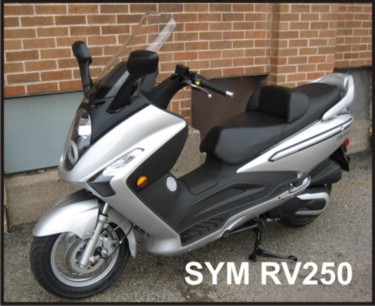

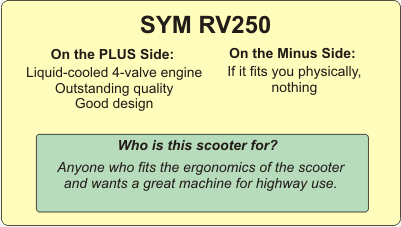 Speedometer Reading/Speed/Fuel Economy
Speedometer Reading/Speed/Fuel Economy